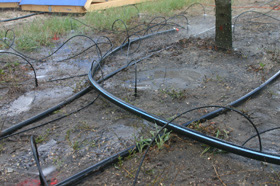Home > Planting trees > Establishing trees in the landscape > Irrigation
Irrigation
Amount and frequency of irrigation
 Irrigation capabilities at the planting site should be considered before selecting trees
for a planting site. Irrigation not only impacts species selection, but maximum
recommended size of the nursery stock and the tree production method best suited
for the site.
Irrigation capabilities at the planting site should be considered before selecting trees
for a planting site. Irrigation not only impacts species selection, but maximum
recommended size of the nursery stock and the tree production method best suited
for the site.
Determining maximum tree size at planting:
If trees will be irrigated infrequently (just several times) after planting, only seeds, seedlings or small saplings of drought tolerant trees should be planted. Small-sized nursery stock has a small top, so roots come into balance with the tree soon after planting. When roots come into balance with the top of the tree, they usually survive and grow well with rainfall alone in humid climates, or with just the turf and landscape irrigation system in dry desert climates.
With infrequent irrigation, larger trees will grow poorly, die back or be killed from lack of water because they take much longer to establish. If trees will be irrigated regularly only until they are established, drought tolerant trees should be chosen, and nursery stock of any size can be planted. If trees receive irrigation during establishment and then regularly during the life of the tree, or if you are planting in the plant's native range and soil type, any tree regardless of drought tolerance can be planted.
Maximum tree size at planting can be determined by knowing the number of months trees will receive irrigation after planting (see table). For example, if irrigation can be provided for only three months after planting, trees no larger than one inch in caliper should be planted in USDA hardiness zone 9. If trees can be watered for 6 months after planting, larger trees can be installed.
Since root growth is slower in colder climates, irrigation during the growing season in the first twelve months would be required to establish a one-inch tree in hardiness zone 5.
More Information
- Specifics on amount and frequency of irrigation.
- "Determining how many months irrigation should be provided based on climate and tree size at planting"
See: more detailed information on choosing small versus large-sized nursery stock.
Another factor affecting tree size at planting is weed control and the mulch replacement program. If weed growth is not controlled chemically or with mulch application around the tree during the establishment period, small nursery stock may be the best choice.
While large trees are trying to establish, weeds often compete with the limited water supplied to most establishing trees. Small trees establish quickly and therefore are able to better compete with weeds.
Determining appropriate tree production method:
Irrigation practices following planting influence establishment rate of field grown trees differently than those raised in containers. If trees receive regular and frequent irrigation after planting, then trees grown in a nursery by any production method appear to perform equally well after planting to the landscape.
If post-planting irrigation will be infrequent, then hardened-off field grown trees may perform better than those from containers. On average, container trees take a bit longer to establish their roots in the landscape than field-grown trees which means they should be irrigated a few months longer. This is discussed in more detail on the page Selecting trees from the nursery.
Planting in irrigated turf:
In western climates, some trees such as oaks and mandrone grow poorly in lawns and in other areas receiving frequent irrigation. Place these trees in an area receiving less frequent irrigation.

